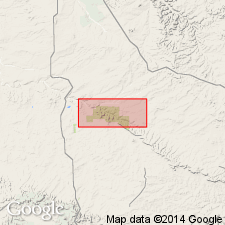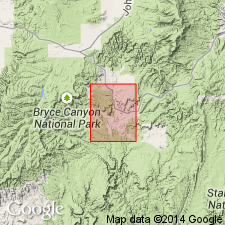
- Usage in publication:
-
- Tsegi Alluvium*
- Modifications:
-
- Redescribed
- Mapped 1:50k
- Dominant lithology:
-
- Alluvium
- Sand
- Silt
- Clay
- Soil
- AAPG geologic province:
-
- San Juan basin
Summary:
Redescribed as alluvium after formation of Hack (1941). Is upper Holocene formation mapped undifferentiated with Naha Alluvium (redescribed) in San Juan and McKinley Cos, NM (San Juan basin). Is yellowish-gray or grayish-brown, firmly consolidated, fine to coarse sand, silt, and clay containing several clay and humus-rich layers. In upper part is weakly developed soil with a yellowish-brown B horizon 6-24 in thick and an underlying moderately firm Cca horizon 15-30 in thick. B horizon contains large well-developed columnar peds as much as 8 in wide and 24 in high. Where the soil was removed by erosion, Tsegi cannot easily be differentiated from overlying Naha. Tsegi either makes up the whole terrace or lies beneath the Naha in the deep arroyo along Chaco Wash and probably is widespread beneath Naha in the valley fills. Thickness about 10 ft.
Source: GNU records (USGS DDS-6; Denver GNULEX).

- Usage in publication:
-
- Tsegi? Alluvium*
- Modifications:
-
- Areal extent
- Geochronologic dating
- AAPG geologic province:
-
- Paradox basin
Summary:
Is provisionally extended into southern UT; mapped locally in southern Garfield Co, UT northeast of confluence of Paria River and Henrieville Creek in Paradox basin and noted to outcrop elsewhere in areas too small to be shown at map scale. Is predominantly valley-fill alluvium consisting of sand and silt and minor gravel. Is 10-30 ft thick; locally forms terrace 10-15 ft above Naha? Alluvium. Radiocarbon dates indicate deposition to about A.D. 550. Radiocarbon dates of A.D. 565 +/-168 yr from charcoal in a hearth 2 ft below surface of Tsegi? and A.D. 542 +/-119 yr from pith juniper tree buried in Tsegi?, which is overlain by Naha?. Dates indicate that the deposits are approximate time equivalents of the typical Tsegi in northern AZ, although correlation with the northern AZ unit is uncertain. Age is late Holocene.
Source: GNU records (USGS DDS-6; Denver GNULEX).
For more information, please contact Nancy Stamm, Geologic Names Committee Secretary.
Asterisk (*) indicates published by U.S. Geological Survey authors.
"No current usage" (†) implies that a name has been abandoned or has fallen into disuse. Former usage and, if known, replacement name given in parentheses ( ).
Slash (/) indicates name conflicts with nomenclatural guidelines (CSN, 1933; ACSN, 1961, 1970; NACSN, 1983, 2005, 2021). May be explained within brackets ([ ]).

